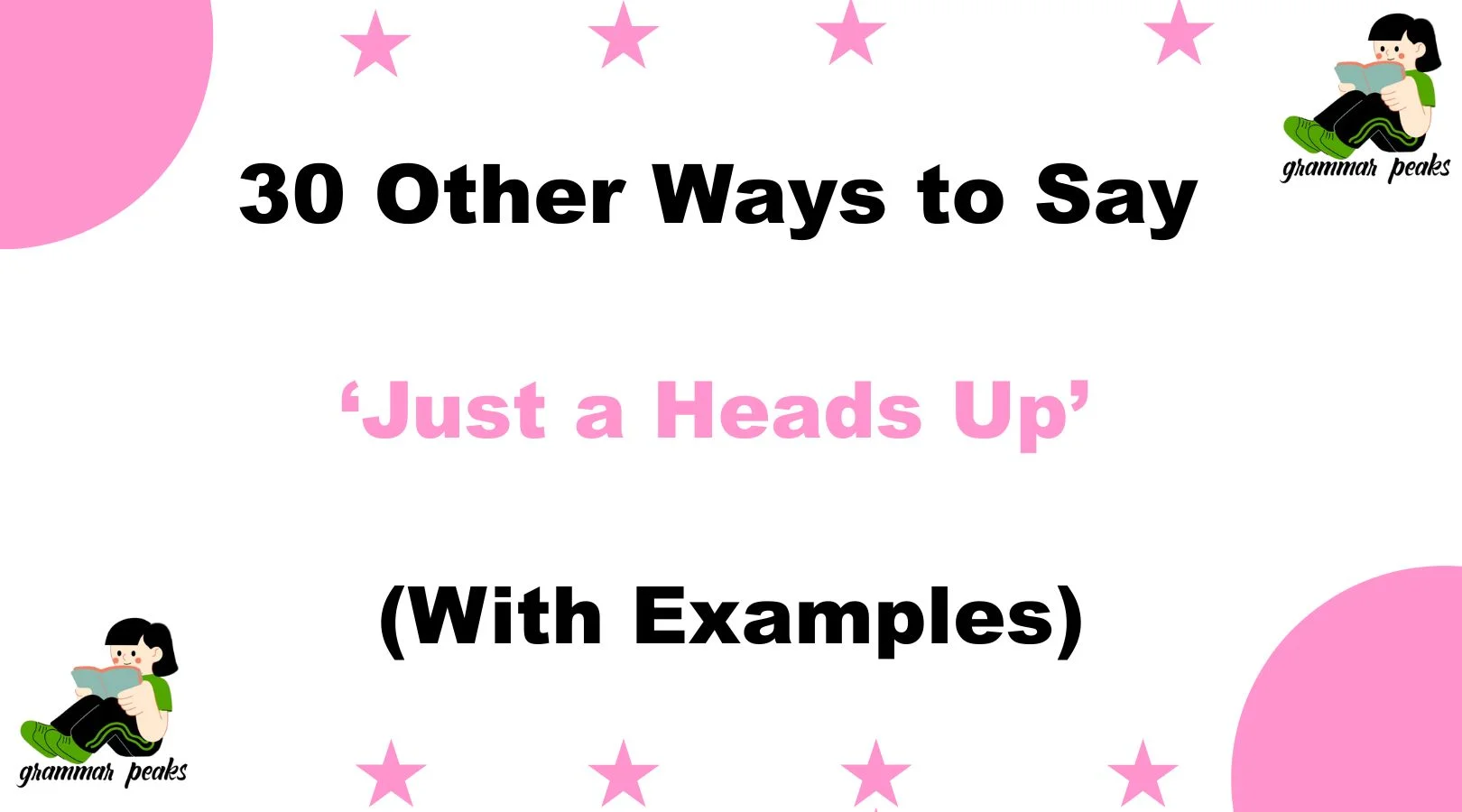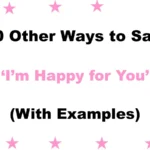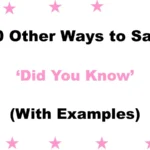Finding the right words to communicate can make all the difference, especially when you want to express care and consideration. Saying “Just a heads up” is a common way to gently alert someone about something important, but sometimes it can feel a bit casual or overused.
Using thoughtful alternatives can make your message feel more personal, warm, and meaningful. Whether you’re writing an email, having a conversation, or sending a quick note, these 30 alternatives will help you express yourself with empathy and clarity, ensuring your message lands just right.
What Does “Just a Heads Up” Mean?
“Just a heads up” is a friendly and informal way to give someone a quick warning or notice about something important or upcoming. It’s often used to gently prepare others for a change, potential issue, or important information without causing alarm.
The phrase shows thoughtfulness, as it helps the listener or reader stay informed and avoid surprises. Whether in casual conversations or workplace chats, it’s a simple way to share helpful insights with care and consideration.
When to Use “Just a Heads Up”
You can use “just a heads up” in casual or semi-formal contexts when you want to:
- Inform someone about a minor change
- Warn gently about something upcoming
- Share a reminder in a friendly way
It’s best used when you want to keep the tone light and conversational.
Is It Professional/Polite to Say “Just a Heads Up”?
The phrase “just a heads up” is generally considered polite and friendly, making it a great choice for casual or semi-formal communication. It conveys a sense of care by giving someone advance notice in a gentle way. However, in highly formal or official settings, this phrase might come across as too casual or informal.
In such cases, using more formal alternatives like “please be advised” or “to bring to your attention” can help maintain professionalism while still being courteous. Ultimately, choosing whether to use “just a heads up” depends on your relationship with the recipient and the tone of the conversation.
Pros and Cons of Saying “Just a Heads Up”
Pros:
- Friendly and approachable tone
- Easy to understand
- Shows thoughtfulness
Cons:
- Can feel too casual in formal settings
- May be overused and lose impact
- Sometimes vague and indirect
Synonyms for “Just a Heads Up”
- A Quick Note
- For Your Awareness
- A Little Reminder
- Just to Keep You Posted
- For Your Information
- To Keep You in the Loop
- Heads-Up Alert
- A Friendly Reminder
- Just So You Know
- For Your Consideration
- A Gentle Warning
- Something to Keep in Mind
- In Case You Didn’t Know
- Letting You Know
- To Bring to Your Attention
- Just a Quick Update
- Please Be Advised
- For Your Benefit
- FYI (For Your Information)
- Just a Quick Heads-Up
- To Keep You Prepared
- For Your Review
- To Flag Something
- As a Reminder
- Just Bringing This Up
- Just a Word of Caution
- For Your Notice
- To Alert You
- Just an FYI
- A Brief Advisory
1. A Quick Note
Definition: A short message intended to give brief information.
Explanation: This phrase implies that what you’re about to say is important but concise.
Scenario Example: A quick note: the report deadline is moved to Friday.
Best Use: When you want to send a concise update or reminder.
Worst Use: Avoid if the message requires detailed explanation.
Tone: Polite, clear, and efficient.
2. For Your Awareness
Definition: Bringing something to someone’s knowledge intentionally.
Explanation: It sounds a bit formal, highlighting the importance of the information.
Scenario Example: For your awareness, the server will be down tonight.
Best Use: Formal emails or communications with colleagues or clients.
Worst Use: Too stiff for casual conversations.
Tone: Professional and respectful.
3. A Little Reminder
Definition: A gentle prompt to remember something.
Explanation: Adds warmth and care to a reminder.
Scenario Example: A little reminder: please submit your timesheets by Thursday.
Best Use: Friendly but clear reminders.
Worst Use: When the reminder is urgent or critical.
Tone: Warm and considerate.
4. Just to Keep You Posted
Definition: Keeping someone informed about ongoing developments.
Explanation: Casual and conversational phrase that suggests ongoing communication.
Scenario Example: Just to keep you posted, the project is on track for completion.
Best Use: Informal updates to peers or team members.
Worst Use: Avoid formal or client-facing communications.
Tone: Friendly and approachable.
5. For Your Information
Definition: Providing facts or details someone may need to know.
Explanation: Neutral and straightforward, suitable for many situations.
Scenario Example: For your information, the policy has changed as of today.
Best Use: When giving official or factual information.
Worst Use: Can sound blunt if overused.
Tone: Neutral and factual.
6. To Keep You in the Loop
Definition: Ensuring someone stays informed about developments.
Explanation: Informal and friendly, emphasizing inclusivity.
Scenario Example: To keep you in the loop, we’ve rescheduled the meeting.
Best Use: Team communication and informal updates.
Worst Use: Not ideal for formal business contexts.
Tone: Warm and inclusive.
7. Heads-Up Alert
Definition: A slightly stronger warning or notice.
Explanation: Adds urgency without being alarming.
Scenario Example: Heads-up alert: the client might request changes.
Best Use: When a prompt warning is necessary.
Worst Use: Overuse can cause unnecessary concern.
Tone: Cautious and clear.
8. A Friendly Reminder
Definition: A polite nudge about something important.
Explanation: Conveys care and respect.
Scenario Example: A friendly reminder: the deadline is tomorrow.
Best Use: To maintain politeness while reminding.
Worst Use: Avoid if the issue is very urgent.
Tone: Courteous and warm.
9. Just So You Know
Definition: Informing someone about something they may not be aware of.
Explanation: Casual and conversational.
Scenario Example: Just so you know, the meeting has been canceled.
Best Use: Informal settings or friendly chats.
Worst Use: Can sound dismissive if not used carefully.
Tone: Casual and conversational.
10. For Your Consideration
Definition: Asking someone to think about something thoughtfully.
Explanation: Polite and respectful phrase often used before a request.
Scenario Example: For your consideration, please review the attached proposal.
Best Use: Formal emails and polite requests.
Worst Use: Too formal for casual updates.
Tone: Respectful and professional.
11. A Gentle Warning
Definition: A soft cautionary notice about something important.
Explanation: This phrase indicates care while alerting someone to a potential issue or upcoming event.
Scenario Example: A gentle warning that the deadline is approaching fast.
Best Use: When you want to warn someone kindly without causing alarm.
Worst Use: Avoid if the situation requires urgent or strict attention.
Tone: Caring and cautious.
12. Something to Keep in Mind
Definition: A phrase used to highlight an important point to remember.
Explanation: It gently encourages awareness without sounding demanding.
Scenario Example: Something to keep in mind: the office will be closed on Friday.
Best Use: Friendly reminders or advice.
Worst Use: Not suitable for urgent alerts.
Tone: Supportive and thoughtful.
13. In Case You Didn’t Know
Definition: Providing information that might be new or surprising to someone.
Explanation: A conversational way to share details or updates.
Scenario Example: In case you didn’t know, the parking lot is under maintenance.
Best Use: Casual conversation or informal emails.
Worst Use: Can sound condescending if not used carefully.
Tone: Informal and conversational.
14. Letting You Know
Definition: Informing someone about something directly.
Explanation: Straightforward and simple, used in various contexts.
Scenario Example: Letting you know that the meeting time has changed.
Best Use: Everyday communication with colleagues or friends.
Worst Use: Too casual for formal announcements.
Tone: Neutral and clear.
15. To Bring to Your Attention
Definition: A formal phrase to highlight important information.
Explanation: Shows respect and importance of the message.
Scenario Example: To bring to your attention, the budget review is scheduled for Monday.
Best Use: Formal emails and professional discussions.
Worst Use: Too heavy for casual updates.
Tone: Professional and respectful.
16. Just a Quick Update
Definition: A brief notification about recent developments.
Explanation: Suggests the message is important but concise.
Scenario Example: Just a quick update: the client approved the design.
Best Use: Quick progress reports or status updates.
Worst Use: Inadequate for detailed explanations.
Tone: Friendly and efficient.
17. Please Be Advised
Definition: A formal warning or notification.
Explanation: Signals that the information is important and should be noted carefully.
Scenario Example: Please be advised that the office hours will change next week.
Best Use: Formal notices and official communications.
Worst Use: Sounds too stern for casual remarks.
Tone: Formal and serious.
18. For Your Benefit
Definition: Information shared to help or support the recipient.
Explanation: Emphasizes helpful intent behind the message.
Scenario Example: For your benefit, here are some tips to improve workflow.
Best Use: When offering advice or assistance.
Worst Use: Avoid if it sounds presumptuous or patronizing.
Tone: Helpful and considerate.
19. FYI (For Your Information)
Definition: Common abbreviation to share information.
Explanation: Neutral and widely understood, often used in emails.
Scenario Example: FYI, the software update will happen at midnight.
Best Use: Casual to semi-formal information sharing.
Worst Use: Can seem impersonal if overused.
Tone: Neutral and straightforward.
20. Just a Quick Heads-Up
Definition: A brief, friendly warning.
Explanation: Similar to “just a heads up” but emphasizes brevity.
Scenario Example: Just a quick heads-up: parking will be limited tomorrow.
Best Use: Short notices among colleagues or friends.
Worst Use: Not suitable for complex or critical info.
Tone: Casual and concise.
21. To Keep You Prepared
Definition: Informing someone to help them get ready.
Explanation: Shows foresight and concern for the recipient’s readiness.
Scenario Example: To keep you prepared, the client may request extra documents.
Best Use: When advance preparation is needed.
Worst Use: Avoid if no preparation is necessary.
Tone: Thoughtful and supportive.
22. For Your Review
Definition: Asking someone to examine or consider something.
Explanation: Polite and formal, often used in business communication.
Scenario Example: For your review, please find the attached proposal draft.
Best Use: Professional and official correspondence.
Worst Use: Too formal for informal alerts.
Tone: Respectful and professional.
23. To Flag Something
Definition: To bring attention to an issue or detail.
Explanation: Informal phrase meaning to highlight or point out.
Scenario Example: Just wanted to flag something in the report that needs correction.
Best Use: Internal team communication.
Worst Use: Avoid in very formal settings.
Tone: Casual and direct.
24. As a Reminder
Definition: A phrase used to recall something important.
Explanation: Polite and clear way to reinforce information.
Scenario Example: As a reminder, please submit your expenses by Friday.
Best Use: Friendly reminders to colleagues or clients.
Worst Use: Avoid if the reminder is too late or ignored.
Tone: Courteous and professional.
25. Just Bringing This Up
Definition: Casual way to introduce a topic or concern.
Explanation: Softens the introduction of a point that may need attention.
Scenario Example: Just bringing this up in case you weren’t aware of the deadline.
Best Use: Informal conversations or emails.
Worst Use: Not suitable for urgent issues.
Tone: Friendly and informal.
26. Just a Word of Caution
Definition: A polite warning about potential risks.
Explanation: Shows care while alerting to possible problems.
Scenario Example: Just a word of caution: the website may experience downtime.
Best Use: When alerting someone tactfully.
Worst Use: Avoid if the issue is severe or urgent.
Tone: Considerate and gentle.
27. For Your Notice
Definition: Formal way to inform someone about something important.
Explanation: Emphasizes that the recipient should be aware of the info.
Scenario Example: For your notice, the policy has been updated.
Best Use: Official communications.
Worst Use: Too formal for casual use.
Tone: Professional and clear.
28. To Alert You
Definition: To warn or inform someone about something.
Explanation: Indicates urgency or importance.
Scenario Example: To alert you, there is a security update required.
Best Use: When timely attention is necessary.
Worst Use: Avoid if the situation is minor.
Tone: Serious and direct.
29. Just an FYI
Definition: Informal abbreviation for “for your information.”
Explanation: Casual and quick way to share info.
Scenario Example: Just an FYI, the meeting is postponed to next week.
Best Use: Informal emails or chats.
Worst Use: Can seem too casual in formal contexts.
Tone: Casual and neutral.
30. A Brief Advisory
Definition: A short, official notification or warning.
Explanation: Formal and concise, suitable for official announcements.
Scenario Example: A brief advisory: the system will undergo maintenance tonight.
Best Use: Business communications or public announcements.
Worst Use: Too formal for personal conversations.
Tone: Formal and authoritative.
Conclusion
Having a variety of ways to say “just a heads up” helps you express yourself with warmth, care, and clarity. Each alternative suits different situations—whether you want to be formal, friendly, cautious, or direct. Choosing the right phrase enhances your communication by showing respect for your audience and ensuring your message feels meaningful and thoughtful.
Remember to consider the tone, context, and relationship when picking a phrase. With these 30 options, you’re equipped to notify, remind, or alert others in a way that truly connects.
FAQs
1. What does “just a heads up” really mean?
It means giving someone a friendly warning or notice about something important or upcoming, often to prepare them or avoid surprises.
2. When is it best to use “just a heads up”?
Use it when you want to inform someone casually about something they should know, usually in informal or semi-formal settings.
3. Are there more formal ways to say “just a heads up”?
Yes! Phrases like “please be advised,” “to bring to your attention,” or “a brief advisory” are great formal alternatives.
4. Can I use “just a heads up” in professional emails?
It depends on the tone and relationship. For formal or important communications, more professional phrases are recommended. For casual team updates, “just a heads up” can work.
5. How do I choose the right alternative for different situations?
Consider your audience, the importance of the message, and the tone you want to convey. For example, use friendly phrases with close colleagues and formal ones in official communication.
6. Is it okay to use abbreviations like “FYI” instead of “just a heads up”?
Yes, FYI is widely accepted in casual and many professional communications, but avoid it if the message requires more warmth or formality.

Mariah Cannon is a dedicated Senior Content Specialist at GrammarPeaks, known for her clear, engaging writing and deep knowledge of English grammar and usage. With a background in linguistics and years of experience in content development, Mariah crafts informative and accessible articles that empower readers to master the nuances of the English language. Her work reflects a commitment to clarity, education, and helping others express themselves with confidence.





